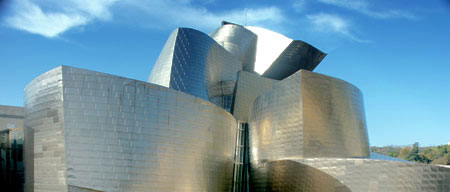Home > Study in Spain > City Guide > Bilbao
Bilbao City Guide
- Places of Interest
- Maps
- Getting to
- Getting around the city
The biggest and busiest city in the Basque country, Bilbao is a place that has come into its own in recent decades. A victim of industrialism, Bilbao was once known as a city of sprawling grey buildings with little to recommend it. However, this was all to change in the 1990s, when masterful planning and hard work transformed the city into the 21st century metropolis we know today; a hub of cultural activity and architectural dexterity. At the centre of this is the Guggenheim Museum, or "El Goog" as it is affectionately known by Bilbaínos, famous the world over. However, there is so much more to Bilbao than simply the Guggenheim.
In 1300, Bilbao became a villa, or city state, and merely consisted of Las Siete Calles, the original seven streets of the old town, and the wharves of San Antón and Abando. However, the conquest of the Americas stimulated trade and strong links were formed with big cities such as Boston. By the late 19th century, the city had become a centre of industrialism, with steelworks, shipbuilding yards and chemical plants shaping the city's landscape. During the Civil War, Bilbao's industrial worth made it very attractive to Franco, who took it in 1937 and tried to silence the Basque Nationalist Movement.
Today it is practically impossible to imagine Bilbao as this sprawling nightmare of industrialism. The city buzzes with vibrant nightlife, a plethora of cultural opportunities and that overriding feel of Basqueness that makes the cities in this region so intriguing. If you are looking for a place where you can party all night while still finding time to take in some of the finest museums in the world, then Bilbao is the place for you.
Places of Interest
Casco Viejo
Built around the original Siete Calles, this maze of unusual façades, shops, bars and cafés is a joy to wander around simply soaking up the atmosphere. Watch the daily mid-morning performance of delivery vans vying for space in the streets, all part of the chaotic atmosphere that makes this quarter what it is.
Santiago Cathedral
Only officially made a cathedral in 1950, this building is said to date back to well before the foundation of the city in 1300, when Bilbao was merely a fishing village. The building is made up of a mixture of styles, the most striking being its Renaissance portal, giving access to the ostentatious Gothic façade and spiral. There is also a beautiful Gothic cloister.
Funicular de Artxanda
For a breath-taking view of Bilbao, take the 3-minute funicular ride up the Artxanda hill. The base station in Plaza Funicular is reached via a scenic walk along the river from the Guggenheim.
La Ribera Market
This market, famous for its amazing selection of seafood, has an eclectic style and beautiful glasswork. After the floods of 1983, the building was reformed and modernized in both its structure and facilities.
Museums
Museo Guggenheim
A trip to Bilbao is not complete without a visit to the Guggenheim, the symbol of the modernizing force that swept through Bilbao at the end of the 20th century. Built on the river, with stunning curvaceous architecture, designed to catch the light, it has been hailed as one of the most impressive examples of Deconstructivist architecture. Inside, the museum houses a spectacular collection of contemporary artwork by both Spanish and international artists alike. There is a permanent collection as well as temporary exhibitions on show. Make sure you visit the Open Air Gallery, situated between the central atrium and the Ría de Bilbao, where a simple pool of water intermittently emits a "mist sculpture". A visit to the Guggenheim is absolutely essential as it is said to be the building that "put Bilbao on the map".
Fine Arts Museum
Situated just five minutes from the Guggenheim, in the Doña Casilda Iturrizar Park, is one of Spain's main painting and sculpture museums. This museum houses works by Van Dyck, Goya, de Ribera and El Greco, to name but a few.
Museo Vasco
This museum, fully entitled The Museum of Basque Archaeology, Ethnography and History, displays a variety of archaeological findings from the Basque region, with exhibits about traditional working practices and domestic life. The museum is housed in a beautiful building, with a cloister in its centre that was part of a 17th century Jesuit building.
Maps
Getting to Bilbao
By Air
Bilbao International Airport, located in Loiu, 10km away from the city centre, has 400 flights that take off a week to a variety of international destinations.
By Sea
P&O Ferries run a service twice a week between Portsmouth and Bilbao.
By Bus
From the main bus station, Termibus, services run to Madrid, Barcelona, Burgos, Vittoria, Pamplona, Logroño, the French border, Santander, Oviedo and San Sebastián.
By Train
The train station is situated just across the river from the Casco Viejo. There are two trains daily to Madrid and Barcelona. Trains also run to Valladolid and Burgos.
Getting around the city
Bilbao has a multitude of public transport to take advantage of. There is a tram and bus system, which stops at places such as the Termibus station, the Guggenheim and the Casco Viejo, and costs just 1€ (NB tickets must be verified in the machine next to the ticket machine before boarding). There is also a metro system that runs to the main focal points of the city, as well as to the beaches close to Bilbao.
Tips
Bilbao can be quite expensive, with rent for a one bedroom city centre apartment being up to 650€ a month, although it is a student city so there are cheap places to go out to eat and drink if you look for them. Stay away from the Calle San Francisco after sundown, as it gets seriously seedy. Apart from this, Bilbao is one of the safest cities in Europe. It has developed a bad reputation for its links with the terrorist group ETA, but despite what people think, this goes pretty much unnoticed in day to day life.

